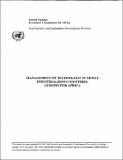Management of technology in newly industrialising countries: lesson for Africa

View
Download
Published
2000-08Author(s)/Corporate Author (s)
United Nations. Economic and Social Council;United Nations. Economic Commission for Africa;
Metadata
Show full item recordAbstract
Technological development has been recognised as the key driving force in economic development not only in industrially advanced countries but also in Newly Industrializing Countries (NICs). Korea, for instance, suffered from almost all the difficulties facing most poor countries today. But its economy grew at an average rate of almost 9 percent through the mid-1990s, raising its GNP per capita in current prices from $87 in 1962 to over $10,000 by 1995. Korea's export increased from a mere $40 million to over $125 billion during the same period. Korea began exporting primary goods in the 1950s, but semiconductors, automobiles, telecommunications system and industrial plants became major export items in the 1990s. How did Korea and other NICs do it? This paper first presents four analytical frameworks - technology trajectory, technology policy/strategy, absorptive capacity and technology transfer. These frameworks provide useful analytical tools to discuss technology policies and strategies in developing countries.
Citation
“United Nations. Economic and Social Council; United Nations. Economic Commission for Africa (2000-08). Management of technology in newly industrialising countries: lesson for Africa. UN. ECA The Advisory Board on Science and Technology Meeting. (3rd : 2000, Oct. 2-4: Addis Ababa, Ethiopia).. Addis Ababa:. © UN.ECA. https://hdl.handle.net/10855/1437”Conference
UN. ECA The Advisory Board on Science and Technology Meeting. (3rd : 2000, Oct. 2-4: Addis Ababa, Ethiopia).Collections
- Natural Resources [3323]
- Organizational Management [4892]
- Science and Technology [1357]
